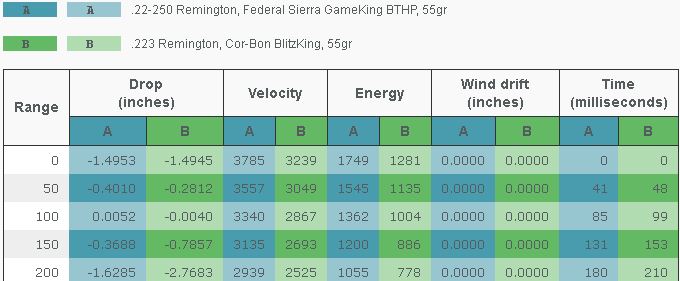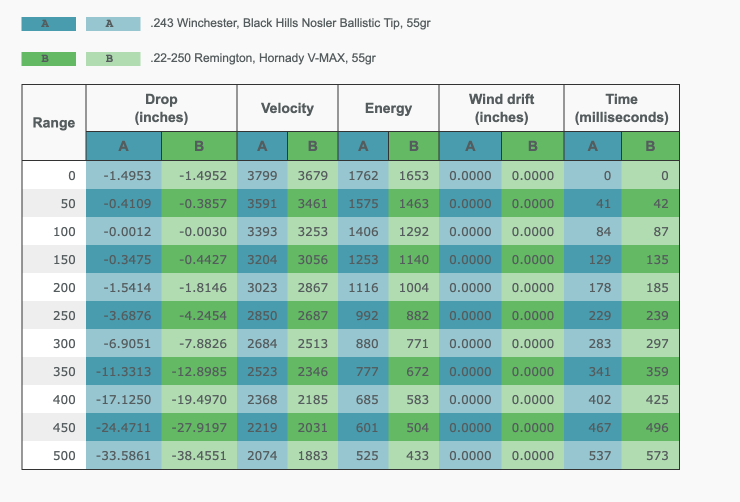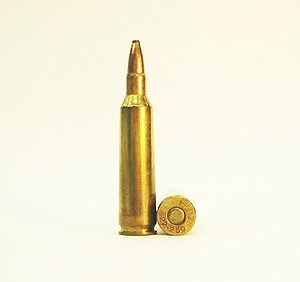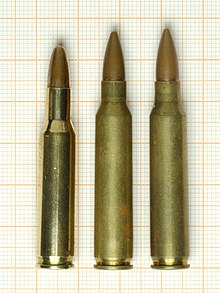With hunting season right around the corner, many hunters are capitalizing on annual hunting sales and gearing up for another season. Now is as good a time as any to purchase a new hunting rifle, you can get plenty of practice done before gun season rolls along.
That’s why in today’s article, we’re going to be comparing the 22 250, 243, and 223 cartridges. While primarily these rounds are a favorite of varmint hunters to take down coyotes, the 22 250 is not unheard of in deer hunting, even if it is an unusual choice. We’ve gathered ballistics charts, as well as our own opinion of these rounds below.
22 250 vs 223 vs 243
If we’re comparing rounds which are in all other aspects equal, the .22-250 has a slight ballistics advantage over the .223 round. The 22-250 also tends to be more accurate, and this is enough to make it an extremely popular coyote round, an area where small drops could put your bullet out of the kill zone and send you home from your hunt empty handed.

Both have fairly negligible recoil, and hunters are not likely to notice much difference there. Though you may be more interested in the fact that .223 is more readily available and cheaper to acquire, likely due to the .22 250’s popularity. So, if you’re a high volume shooter, the 223 may be more attractive for this reason alone. Plus, when ammo shortages abound, the 223 is more likely to be in-stock. Allowing you to keep shooting and hunting while other guys wait for ammo stock to return to the shops.

As for the 243, it carries more power than both the 22 250 and 223, and it does so at a greater distance. It’s a better choice if you’re looking for a versatile round which can more easily take down both coyotes and deer, BUT if you are hunting coyotes with the hopes of salvaging their pelts to sell them, you should know that the 243 is not “fur friendly”. It will likely do significant damage to your pelts, which can impact your profits.
If this is the case for you, then you’ll be better served to stick with the 22 250, because it will do much less damage. If you’re interested in reading more about these individual rounds and seeing our ballistics data, keep reading for more on that!
(PS. Looking for a fur friendly coyote hunting method? Have you considered taking some coyote shotgun loads for a spin?)
22 250 Remington Overview
- Bullet diameter: .224 in (5.7mm)
- Case length: 1.912 in (48.6mm)
- Twist: 1-12, 1-14
- Availability: Excellent
Bullet mass/type | Velocity | Energy |
55gr. (3.6g) SP | 3786 ft/s (1154 m/s) | 1751 ft⋅lbf (2343 J) |
60gr. (3.9g) BT | 3580 ft/s (1090 m/s) | 1708 ft⋅lbf (2316 J) |
64gr. (4.1g) PP | 3500 ft/s (1100 m/s) | 1741 ft⋅lbf (2360 J) |
The 22-250 Remington is a high velocity round preferred by varmint and small game hunters. Actually it’s probably the preferred round for coyote hunting.
However, it can be a useful deer gun in states where permitted, and many hunters swear by its performance. Partially due to how accurate it is.
Obviously, 200+ yard shots can be risky, compounded by the lower kinetic energy and smaller bullet. However, with great shot placement and closer ranges, taking down deer certainly makes this caliber a viable option if you’re in the market for a varmint gun, and wouldn’t mind getting a crack at a deer without having to carry a bigger rifle on varmint hunts.
What the 22-250 lacks in size it makes up for in speed and trajectory. Some factory loaded cartridges can hit speed in excess of 4000 ft/s! The extremely high velocity of the projectile allows for much flatter shooting, and greater effectiveness in windy conditions.
The recoil is almost negligible and so the 22-250 can be extremely accurate, even for novice shooters. Anecdotal research leads me to believe that while the 22-250 might not be the most popular choice for hunting deer, it is certainly a viable option for doing so where legal.
Not surprisingly, shot placement is the key to success. My call is if you are confident in your shot, shooting less than 200 yards, and it is legal, then consider using a 22-250 the next time you’re out looking for deer.
However, if you are keen to hunt coyotes, then the 22 250 is pretty much the go-to in that department. This round hits hard and is deadly accurate, an important factor when hunting a smart predator like a coyote. The broadside target of a coyote is around 9 inches, and your front side target is even less, so accuracy is a must-have in coyote hunts.
But, with good shot placement, the 22 250 offers the accuracy to drop a dog in it’s tracks. However, if you need a little help, have a look at our coyote shot placement guide to learn where to shoot a coyote for the best results.
223 Remington Overview
- Bullet diameter: .224 in (5.7mm)
- Case length: 1.76 in (45mm)
- Twist: 1-12,1-7,1-10
- Availability: Excellent
Bullet mass/type | Velocity | Energy |
55gr. (3.5g) NBT | 3240 ft/s (990 m/s) | 1265 ft⋅lbf (1715 J) |
60gr. (3.9g) NP | 3160 ft/s (960 m/s) | 1325 ft⋅lbf (1796 J) |
69gr. (4.48g) BTHP | 2950 ft/s (900 m/s) | 1338 ft⋅lbf (1814 J) |
The 223 Remington is perhaps the most popular caliber out there. It has uses in military, sporting, and hunting.
While it may be very similar to the 22 250, the 223 is slower on average, and thus has lower energy. Legality aside (most states will cover this in their hunting regs) the 223 is also a flat shooting caliber. It is practically identical to the 22-250, with large variances in bullet drop occurring at the 150-yard range. If you’re in the market for a new rifle, there are much more choices in terms of firearms chambered in 223 than there are in 22-250.
I see the 223 being a good choice if I’m looking for a highly customizable AR variant with both varmint, deer and sporting capabilities. However, if energy and velocity are more important, the 22-250 should be your choice.
When it comes to the 223 vs 243 recoil, you may find that hunting with a 243 may tire you out after a long day, but the 223 Remington is a faithful and easy to handle companion you’ll be glad to have by your side.
243 Winchester Overview
- Bullet diameter: .243 in (6.2 mm)
- Case length: 2.045 in (51.9 mm)
- Twist: 1-10, 1-8
- Availability: Great
Bullet mass/type | Velocity | Energy |
55gr. (4g) BT | 4058 ft/s (1237 m/s) | 2012 ft⋅lbf (2728 J) |
65gr. (4.1g) BT | 3746 ft/s (1142 m/s) | 2026 ft⋅lbf (2747 J) |
75gr. (5g) HP | 3447 ft/s (1051 m/s) | 1979 ft⋅lbf (2634 J) |
When it comes to the 22 250 vs 243 rounds. The 243 is faster and has more energy than both. It is a larger diameter bullet, with offerings in everything from 55gr to 105gr bullets. The 243 is a step away from varmint and towards deer. It’s higher energy makes this caliber viable at long range, and more devastating up close.
Almost every sporting rifle manufacturer will make 243 variants. With lower recoil than .30 caliber cartridges, and higher energy than most smaller cartridges, the 243 Winchester fills a niche market among entry level rifles suitable for stalking deer. Where the popular 30-30 reigns supreme, the 243 fits in nicely as a good compromise where lower recoil is desired.
Though the 243 lacks the exceptional accuracy of the 22 250, and it’s not fur friendly. So, if you plan to harvest pelts and sell them, this is likely not the coyote hunting caliber for you. It’s also a bit pricier and less likely to be in-stock during times of uncertainty than the 223, which these days, is a valid concern for a hunter or gun enthusiast.
In closing, the 22 250 will likely be tops for you if you’re looking for an accurate, low-damage round to take down coyotes. However, the 243 can be a great choice if you’re looking for a more multi-purpose round which is more suitable for a all-around hunting. The 223, is an okay round in many departments, but it will likely most appeal to high volume shooters looking for some cheap ammo to play with at the range.




